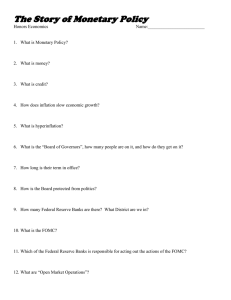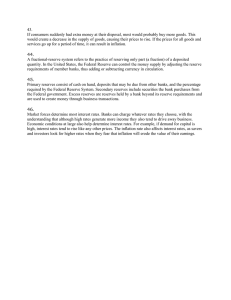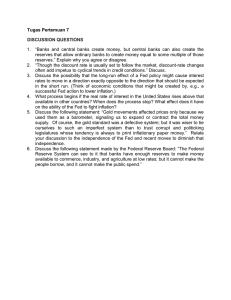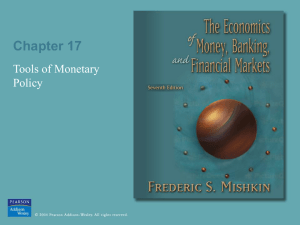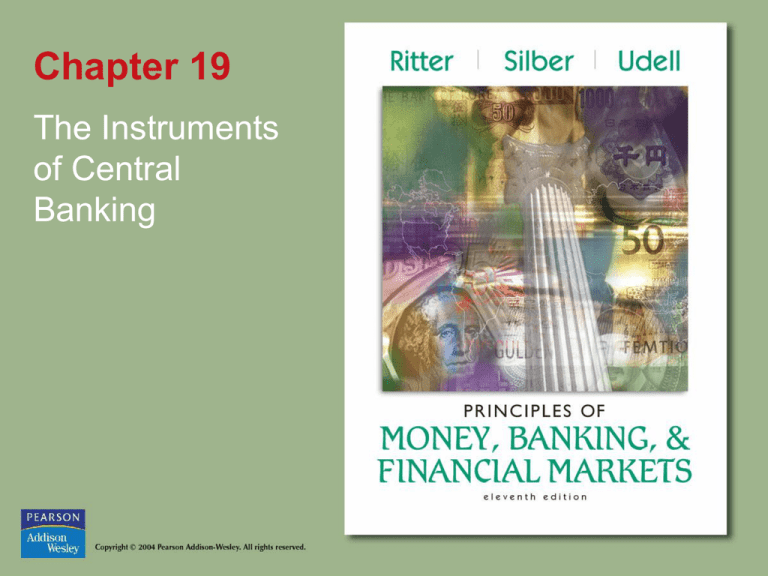
Chapter 19
The Instruments
of Central
Banking
Introduction
• Bank lending and money supply are related
by some multiple to the level of bank reserves
• Federal Reserve exercises control over bank
lending and money supply by altering the
level of reserves in the system and
influencing the deposit creation multiplier
• Fed accomplishes these objectives by
changing the reserve requirements and by
changing the actual amount of reserves held
Copyright © 2004 Pearson Addison-Wesley. All rights reserved.
19-2
Reserve Requirements
• Within limits established by Congress,
Federal Reserve can specify reserve
requirements banks and deposit-type
institution must hold against deposits.
• This applies even if the institution is not
a member of the Federal Reserve
• Reserves can be in form of vault cash
or deposits in regional bank—do not
earn interest
Copyright © 2004 Pearson Addison-Wesley. All rights reserved.
19-3
Reserve Requirements (Cont.)
• Percentage of required reserves varies with
type of account
– Demand Deposits
• Can range between 8% to 14%
• 3% of the first $42.1 million of demand deposits
• Currently set at 10% on deposits above $42.1 million
– Business-owned time and savings deposits
• Can range between zero to 9%
• Currently set at 0%
Copyright © 2004 Pearson Addison-Wesley. All rights reserved.
19-4
Reserve Requirements (Cont.)
• Effect of lowering the reserve
requirement
– Automatically increases all banks’ excess
reserves
– Increases demand deposit through multiple
lending
– However, the ultimate impact depends on
banks desire to make loans— element of
discretion
– Expands the money supply
Copyright © 2004 Pearson Addison-Wesley. All rights reserved.
19-5
Reserve Requirements (Cont.)
• Effect of raising the reserve
requirement
– Decrease banks’ excess reserves and may
force them to take steps to correct a deficit
reserve position
– Restrains lending and deposit creation
– Contracts the money supply
Copyright © 2004 Pearson Addison-Wesley. All rights reserved.
19-6
Reserve Requirements (Cont.)
• Even without legal reserve
requirements, banks would still need to
hold cash reserves as vault cash or on
deposit with Federal Reserve
– Cash to meet customer withdrawals
– Balances at Fed to clear checks
– Without legal reserve requirements, it is
likely the multiplier relationship between
reserves and money supply may fluctuate
considerably
Copyright © 2004 Pearson Addison-Wesley. All rights reserved.
19-7
Discounting and the Discount Rate
• Discount rate—amount the Federal Reserve
charges banks for a temporary loan of
reserves to cover a deficiency
• Ability to borrow means that a bank does not
need to call in loans or sell securities (reduce
money supply) to deal with a deficit
• All depository institutions have access to
borrowing at the discount window, even if
not a member of the Fed
Copyright © 2004 Pearson Addison-Wesley. All rights reserved.
19-8
Discounting and the Discount Rate
(Cont.)
• Federal Reserve influences banks’ desire to
borrow reserves by changing discount rate
– Lower the rate—more borrowing, increase money
supply
– Raising the rate—less borrowing, decrease
money supply
• Actual borrowing (changes in money
supply) depends on banks’ willingness to
use this facility of the FED
Copyright © 2004 Pearson Addison-Wesley. All rights reserved.
19-9
Discounting and the Discount Rate
(Cont.)
• Quantity of discount lending
– Central bank is the ultimate source of liquidity in
the economy
– Lender of last resort—Discount provision was
originally established to permit banks to borrow
from the Fed when threatened with cash drains
– Discount facility should not be used too often to
get banks out of reserve difficulties, primarily when
a bank is temporarily short of cash
Copyright © 2004 Pearson Addison-Wesley. All rights reserved.
19-10
Discounting and the Discount Rate
(Cont.)
• Quantity of discount lending (Cont.)
– Banks should manage affairs so they do
not need to use discount facility very often
– Discounting is a privilege, not a right
– Banks are supposed to use discount facility
because of need, not to make profit
– Prior to 2003, the Fed used extensive
administrative and surveillance procedures
to prevent “abuse”
Copyright © 2004 Pearson Addison-Wesley. All rights reserved.
19-11
Discounting and the Discount Rate
(Cont.)
• Quantity of discount lending (Cont.)
– However, under the new discount lending
procedure, the Federal Reserve charges a
penalty rate above short-term market rates
– In return, the Fed removes conditions and
restrictions for banks that qualify for primary
credit
– The intent of the new policy is to improve access
to discount window borrowing by removing the
negative connotation of borrowing from the Fed
Copyright © 2004 Pearson Addison-Wesley. All rights reserved.
19-12
Discounting and the Discount Rate
(Cont.)
• Discount Rate and Market Interest Rates
– Discounting is discouraged when the rate is
above other short-term rates, and encouraged
when it is below
– In some countries, the discount rate is often kept
above short-term market rates—a penalty rate as
a means of restraining excessive borrowing
– In US, discount rate is usually below Treasury bill
rate so Fed relies on surveillance to prevent
“abuse of the privilege”
Copyright © 2004 Pearson Addison-Wesley. All rights reserved.
19-13
Discounting and the Discount Rate
(Cont.)
• Relationship between discount rate and
other market interest rates
– Discount rate is an “administered” rate, set by Fed
– Weak linkage between discount rate and reserves
and money supply
– Figure 19.1
• Change in the discount rate generally occurs after a
change in the Treasury bill rate or federal funds rate
• Also shows, after January 2003, the new primary credit
rate is now above the rate on three-month T-bill
– Reactive rather than proactive tool
Copyright © 2004 Pearson Addison-Wesley. All rights reserved.
19-14
Figure 19.1 Movements in the discount rate
tend to come after Treasury bill rates
Copyright © 2004 Pearson Addison-Wesley. All rights reserved.
19-15
Discounting and the Discount Rate
(Cont.)
• Relationship between discount rate and
other market interest rates (Cont.)
– “Announcement” effect
• An unexpected change in discount rate will signal that
the Fed desires to change monetary policy
• The public, reacting to this expectation, takes action that
causes the Fed’s desire to occur
– Change in the discount rate usually confirms
what is happening, but does not initiate it
Copyright © 2004 Pearson Addison-Wesley. All rights reserved.
19-16
Open Market Operations
• Fed’s most important tool to alter reserves
• About $3,200 billion worth of marketable
government securities outstanding
– Held by individuals, corporations, and financial
institutions
– Used by the US Treasury to borrow to finance
budget deficits
– The sale of government securities by the
Treasury is independent of the Fed and may
work counter to the Fed’s monetary policy
Copyright © 2004 Pearson Addison-Wesley. All rights reserved.
19-17
Open Market Operations (Cont.)
• Open market operations—Buying and
selling government securities to influence
bank reserves
– Purchase securities—expand reserves (money
supply)
– Sell securities—contract reserves (money
supply)
– Does not matter whether Fed sells/purchases
government securities to/from a bank, other
financial institution, or individual—same result,
assuming the simple multiplier
Copyright © 2004 Pearson Addison-Wesley. All rights reserved.
19-18
Open Market Operations (Cont.)
• Modifications to the simple multiplier
discussed in appendix to Chapter 19 will
impact the ultimate relationship between
changes in reserves and the money supply
• The Federal Reserve permits the market to
set the purchase/sales price of government
securities and, thereby, altering the rate of
interest on that class of securities
Copyright © 2004 Pearson Addison-Wesley. All rights reserved.
19-19
Conducting Open Market
Operations
• The Federal Open Market Committee
(FOMC) in Washington decides on general
aims and objectives of monetary policy and
sets monetary targets (bank reserves, money
supply, and interest rates)
• Buying/selling of government securities takes
place at Federal Reserve Bank of New York
• Located in the heart of the New York financial
district
Copyright © 2004 Pearson Addison-Wesley. All rights reserved.
19-20
Conducting Open Market
Operations (Cont.)
• A day at the trading desk
– Open Market Account manager keeps close
contact with securities dealers to get the “feel of
the market” and what is needed to meet targets
– Uses the federal funds rate as a barometer of
reserve supply relative to demand
– Tries to predict expected currency movements that
can affect reserve position of the banking system
– Contacts the US Treasury to determine what is
happening to Treasury balances in tax and loan
accounts at commercial banks
Copyright © 2004 Pearson Addison-Wesley. All rights reserved.
19-21
Conducting Open Market
Operations (Cont.)
• A day at the trading desk (Cont.)
– Based on FOMC targets and projected
changes in reserve position of the banking
system, decides on appropriate
sales/purchases of government securities
– If changes in bank reserves are considered
to be temporary, the open market account
manager will use repurchase agreement
to offset these transitory reserve movement
Copyright © 2004 Pearson Addison-Wesley. All rights reserved.
19-22

